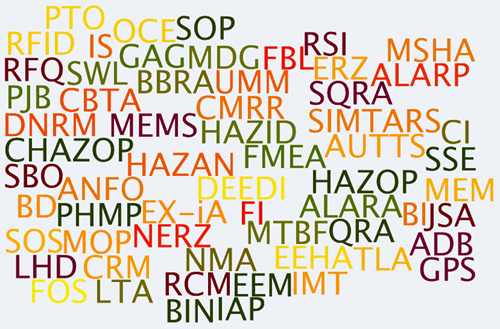TMA (Too Many Acronyms)
Something’s happening here. Something either has been increasing in frequency recently or has started grating on my nerves more: the tendency of authors to introduce numerous and unnecessary acronyms in their manuscripts.
This example comes from George Bryan. Clearly, this one is over the top.
“Comparing each composite MLqv to their respective distribution means, FA CL MLqv and FA HP MLqv are closer to their respective CL and HP distribution means; while HA LP MLqv is closer to the LP distribution mean (Fig. 2a).”
Introducing unnecessary and uncommon acronyms makes it difficult for readers to follow the text, as readers encountering an acronym that they can’t remember are left to flip back through the paper to track it down, slowing down reading the manuscript. Also, acronyms make it difficult for readers who don’t read the manuscript linearly from introduction to conclusion, but instead skip around through the manuscript to get the relevant information they require. Authors may think that they are benefiting the author by having them read fewer words or they may think that they are saving themselves effort by not typing out the same terms over and over again. This reasoning holds no water. It is the authors’ job to make it easy on the readers, not easy on themselves.
Obviously, I’m not talking about standard acronyms that would be well-known to your readers like DNA, NASA, WRF, SST, or MJO, or acroyms that are introduced to save some serious space were it to be used again and again (ERICA IOP 4: Experiment on Rapidly Intensifying Cyclones over the Atlantic Intensive Operations Period 4).
Addressing excessive acronym usage is not within the job of the publications staff, so this is something that we authors, reviewers, and Editors need to police ourselves.
I am asking us all to rethink whether nonstandard acronyms are necessary. Eliminating many, if not all of them, will improve the readability of your manuscript.




As the layout editor for the National Weather Association’s Journal of Operational Meteorology, I have made it a practice of abbreviating citations when 10 or more are used (e.g., Schultz et al. 2010, hereafter S10). I gather that you might not be in favor of this. Part of my reason for doing this is because (i) I have gotten accustomed to the American Meteorological Society’s practice of doing this, (ii) it shortens the paper a little, and (iii) in my opinion, makes the paper look a bit “cleaner.” What is your view on this specific form of abbreviating?